1993 CHEVROLET ASTRO PASSENGER wheel
[x] Cancel search: wheelPage 195 of 345
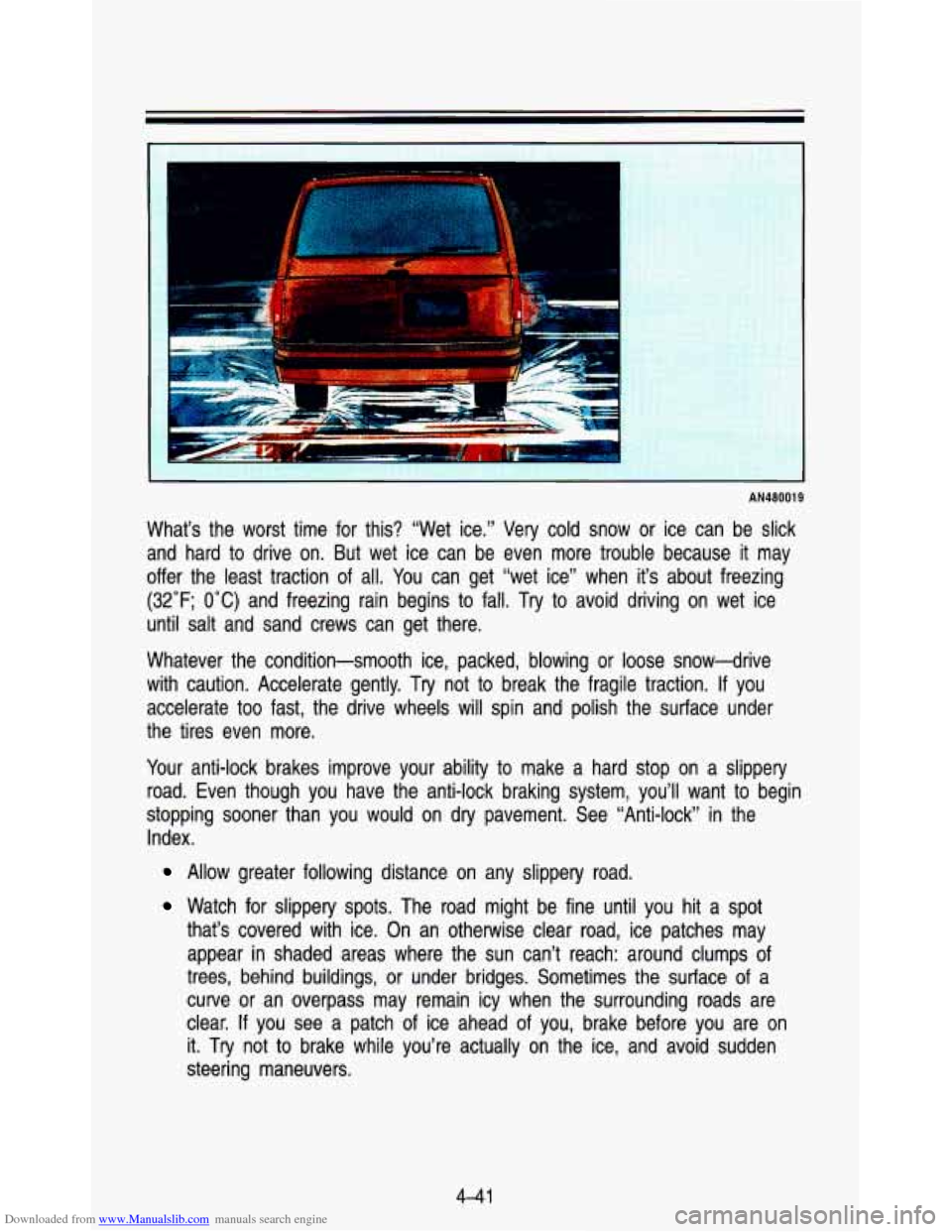
Downloaded from www.Manualslib.com manuals search engine .. .
AN48001 9
What’s the worst time for this? “Wet ice.” Very cold \
snow or ice can be slick and hard to drive on. But wet ice can be even more trouble \
because it may
offer the least traction of all. You can get “wet ice” when it’s about freezing
(32°F; 0°C) and freezing rain begins to fall. Try to avoid driving on wet ice
until salt and sand crews can get there.
Whatever the condition-smooth ice, packed, blowing
or loose snow-drive
with caution. Accelerate gently. Try not to break the fragile \
traction.
If you
accelerate too fast, the drive wheels will spin and polish the\
surface under
the tires even more.
Your anti-lock brakes improve your ability to make a hard stop on \
a slippery
road. Even though you have the anti-lock braking system, you’\
ll want to begin
stopping sooner than you would on dry pavement. See “Anti-lo\
ck” in the Index.
Allow greater following distance on any slippery road.
Watch for slippery spots. The road might be fine until you hi\
t a spot
that’s covered with ice. On an otherwise clear road, ice pa\
tches may
appear in shaded areas where the sun can’t reach: around clumps of
trees, behind buildings, or under bridges. Sometimes the surface\
of a
curve or an overpass may remain icy when the surrounding roads\
are
clear.
If you see a patch of ice ahead of you, brake before you are o\
n
it. Try not to brake while you’re actually on the ice, and avoid sudden
steering maneuvers.
4-41
Page 202 of 345
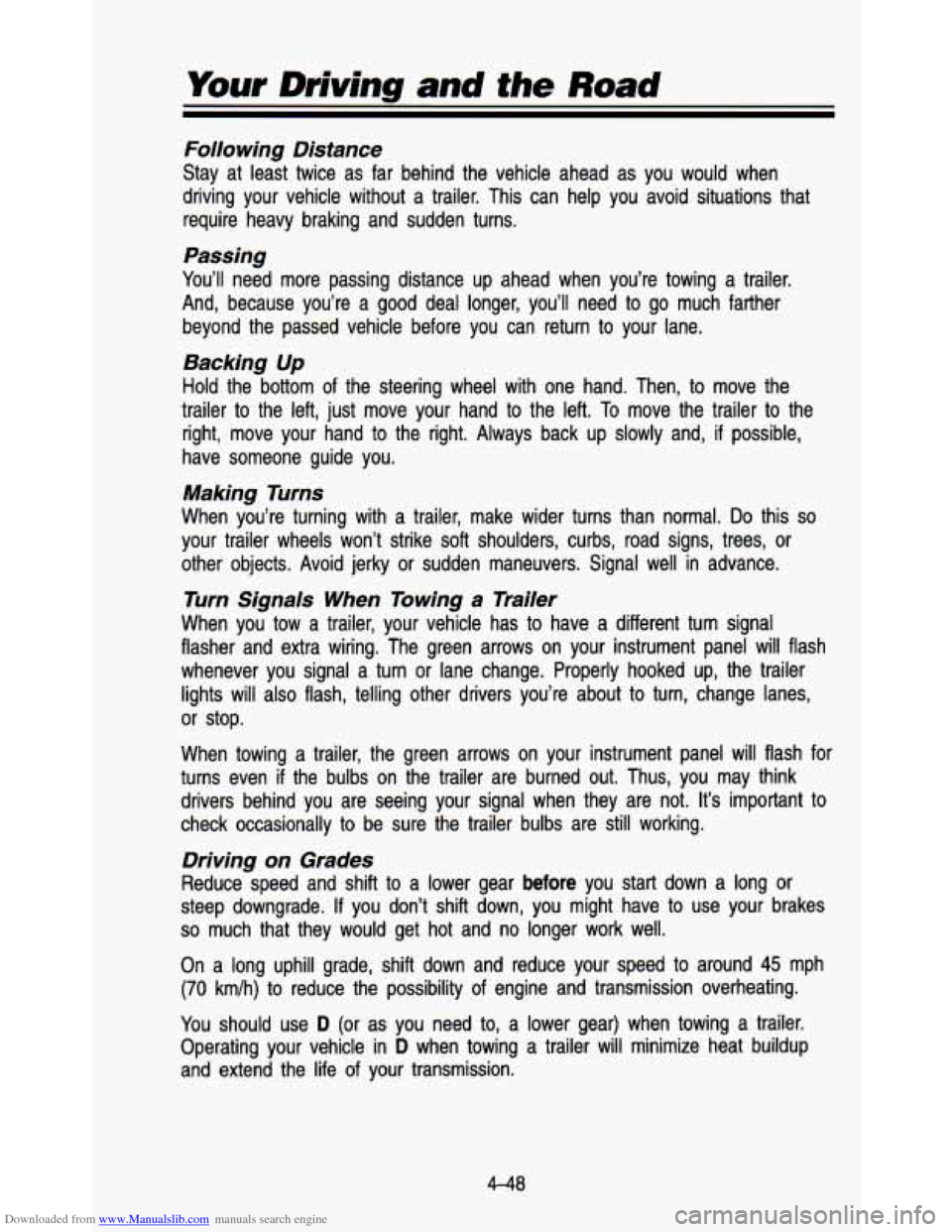
Downloaded from www.Manualslib.com manuals search engine Your Driving and the Road
Following Distance
Stay at least twice as far behind the vehicle ahead as you w\
ould when
driving your vehicle without a trailer. This can help you avoi\
d situations that require heavy braking and sudden turns.
Passing
You’ll need more passing distance up ahead when you’re to\
wing a trailer.
And, because you’re a good deal longer, you’ll need
to go much farther
beyond the passed vehicle before you can return
to your lane.
Backing Up
Hold the bottom of the steering wheel with one hand. Then, to move the
trailer to the left, just move your hand to the left.
To move the trailer to the
right, move your hand to the right. Always back up slowly and\
, if possible,
have someone guide you.
Making Turns
When you’re turning with a trailer, make wider turns than n\
ormal. Do this so
your trailer wheels won’t strike soft shoulders, curbs, road \
signs, trees, or
other objects. Avoid jerky or sudden maneuvers. Signal well in advance.
Turn Signals When Towing a Trailer
When you tow a trailer, your vehicle has to have a different turn signal
flasher and extra wiring. The green arrows on your instrument \
panel will flash
whenever you signal a turn or lane change. Properly hooked up,\
the trailer lights will also flash, telling other drivers you’re about to turn, change lanes,
or stop.
When towing a trailer, the green arrows on your instrument pan\
el will flash for
turns even
if the bulbs on the trailer are burned out. Thus, you may think \
drivers behind you are seeing your signal when they are not. \
It’s important to
check occasionally
to be sure the trailer bulbs are still working.
Driving on Grades
Reduce speed and shift to a lower gear before you start down a long or
steep downgrade. If you don’t shift down, you might have to use your brakes
so much that they would get hot and no longer work well.
On a long uphill grade, shift down and reduce your speed to \
around
45 mph
(70 km/h) to reduce the possibility of engine and transmission overheating.
You should use
D (or as you need to, a lower gear) when towing a trailer.
Operating your vehicle in
D when towing a trailer will minimize heat buildup
and extend the life
of your transmission.
4-48
Page 203 of 345
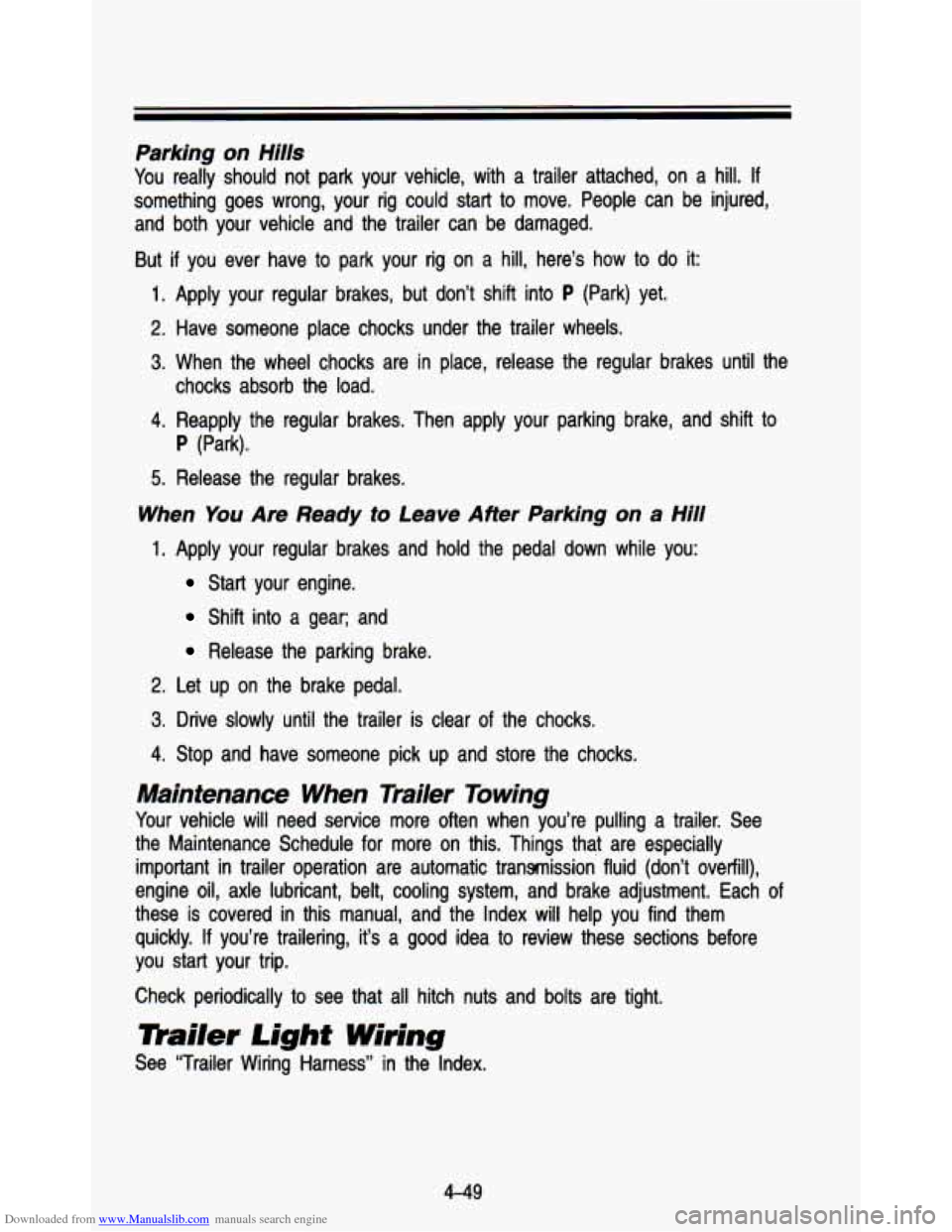
Downloaded from www.Manualslib.com manuals search engine Parking on Hills
You really should not park your vehicle, with a trailer attached, \
on a hill. If
something goes wrong, your rig could start to move. People can be injured,
and both your vehicle and the trailer can be damaged.
But
if you ever have to park your rig on a hill, here’s how to do it:
1. Apply your regular brakes, but don’t shift into P (Park) yet.
2. Have someone place chocks under the trailer wheels.
3. When the wheel chocks are in place, release the regular brakes until the
chocks absorb
the load.
4. Reapply the regular brakes. Then apply your parking brake, and \
shift to
P (Park).
5. Release the regular brakes.
When You Are Ready to Leave After Parking on a Hill
1. Apply your regular brakes and hold the pedal down while you:
Start your engine.
Shift into a gear; and
Release the parking brake.
2. Let up on the brake pedal.
3. Drive slowly until the trailer is clear of the chocks.
4. Stop and have someone pick up and store the chocks.
Maintenance When Trailer Towing
Your vehicle will need service more often when you’re pulling a trailer. See
the Maintenance Schedule for more
on this. Things that are especially
important in trailer operation are automatic transmission fluid (don’t ove\
rfill),
engine oil, axle lubricant, belt, cooling system, and brake adj\
ustment. Each of
these is covered in this manual, and the Index will help you find them
quickly. If you’re trailering, it’s a good idea
to review these sections before
you start your trip.
Check periodically
to see that all hitch nuts and bolts are tight.
mailer Light Wiring
See “Trailer Wiring Harness” in the Index.
4-49
Page 211 of 345
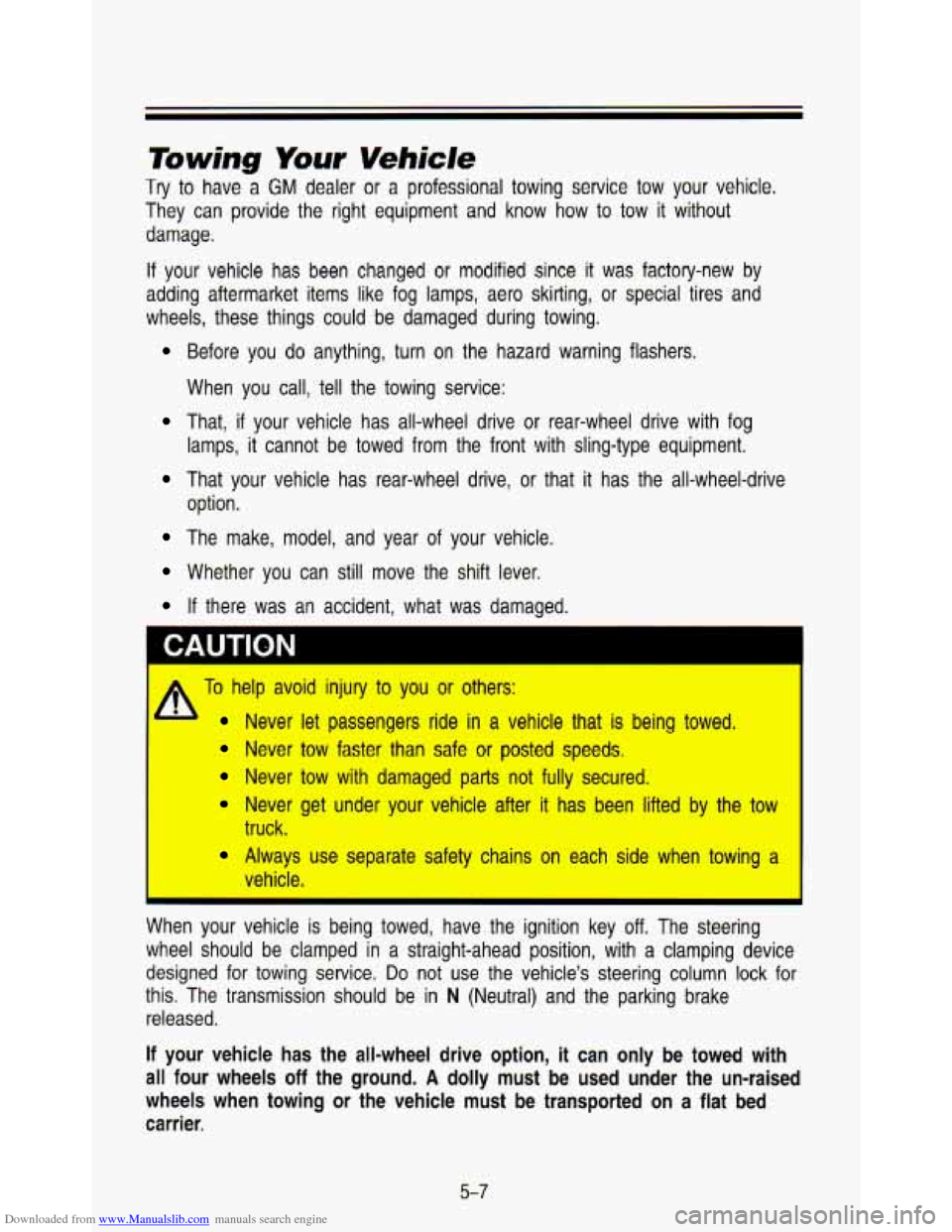
Downloaded from www.Manualslib.com manuals search engine Towing Your Vehicle
Try to have a GM dealer or a professional towing service tow your vehicle.
They can provide the right equipment and know how to tow it without
damage.
If your vehicle has been changed or modified since it was factory-new by
adding aftermarket items like fog lamps, aero skirting, or special tires and
wheels, these things could be damaged during towing.
Before you do anything, turn on the hazard warning flashers.
When you call, tell the towing service:
That, if your vehicle has all-wheel drive or rear-wheel drive with fog
lamps, it cannot be towed from the front with sling-type equipment.
That your vehicle has rear-wheel drive, or that it has the all-wheel-drive
option.
The make, model, and year of your vehicle.
Whether you can still move the shift lever.
If there was an accident, what was damaged.
* To help avoid injury to you or others:
I
Never let passengers ride in a vehicle that is being towed.
Never tow faster than safe or posted speeds.
Never tow with damaged parts not fully secured.
Never get under your vehicle after it has been lifted by the tow
Always use separate safety chains on each side when towing a
truck.
I vehicle.
When your vehicle is being towed, have the ignition key
off. The steering
wheel should be clamped in a straight-ahead position, with a clamping device
designed
for towing service. Do not use the vehicle’s steering column lock for
this. The transmission should be in
N (Neutral) and the parking brake
released.
If your vehicle has the all-wheel drive option, it can only be towed with
all four wheels
off the ground. A dolly must be used under the un-raised
wheels when towing or the vehicle must be transported
on a flat bed
carrier.
5-7
Page 212 of 345
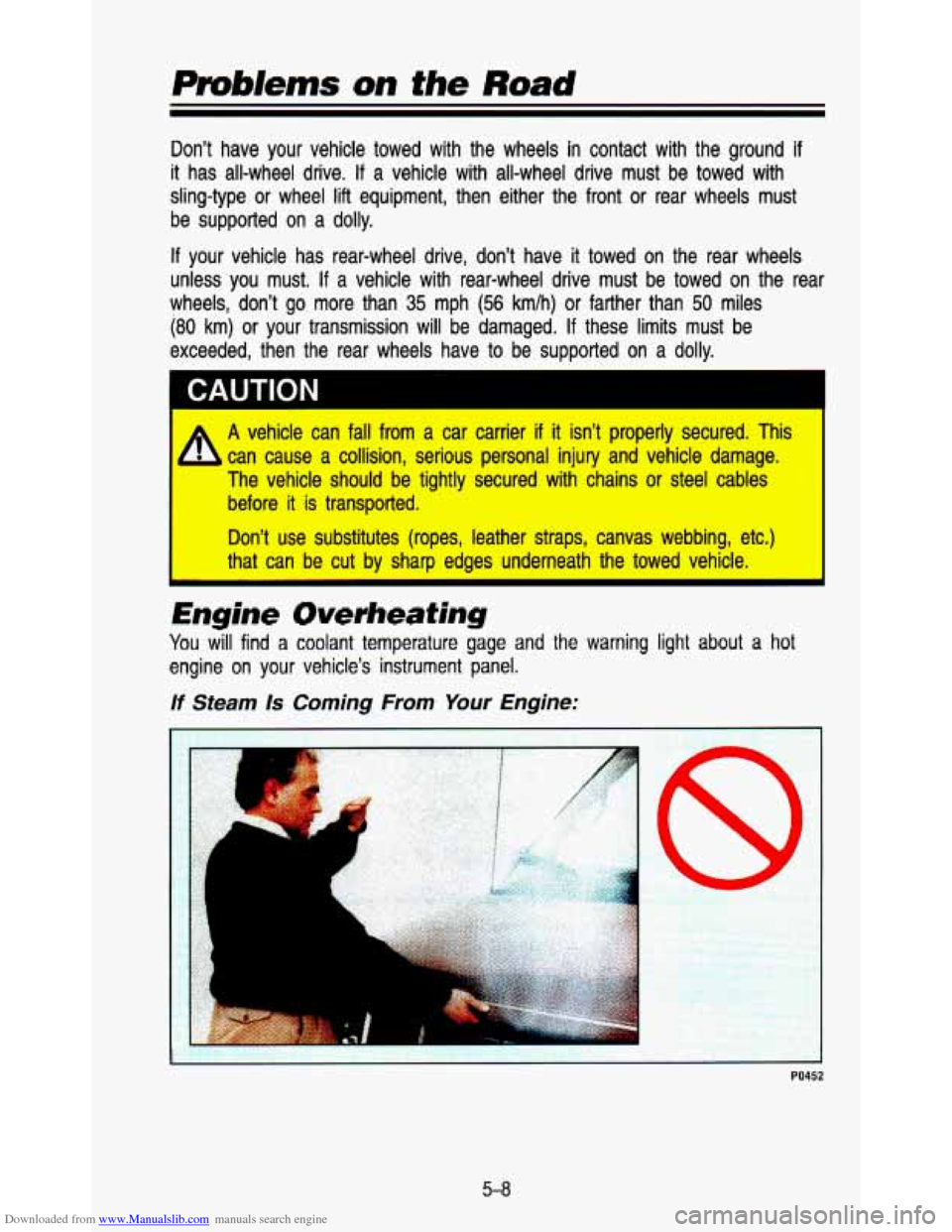
Downloaded from www.Manualslib.com manuals search engine Don’t have your vehicle towed with the wheels in contact with the ground if
it has all-wheel drive. If a vehicle with all-wheel drive must be towed with
sling-type
or wheel lift equipment, then either the front or rear wheels must
be supported on a dolly.
If your vehicle has rear-wheel drive, don’t have it towed on t\
he rear wheels
unless you must.
If a vehicle with rear-wheel drive must be towed on the rear
wheels, don’t go more than
35 mph (56 kmlh) or farther than 50 miles
(80 km) or your transmission will be damaged. If these limits must be
exceeded, then the rear wheels have to be supported on a doll\
y.
1 CAUTION
L A vehicle can fall from a car carrier if it isn’t properly secured. This
b can cause a collision, serious personal injury and vehicle dama\
ge.
The vehicle should be tightly secured with chains or steel cab\
les
before it is transported.
Don’t use substitutes (ropes, leather straps, canvas webbing,\
etc.)
that can be
cut by sharp edges underneath the towed vehicle.
Engine Overheating
You will find a coolant temperature gage and the warning light about a hot
engine on your vehicle’s instrument panel.
If Steam Is Coming From Your Engine:
PO452
5-8
Page 220 of 345
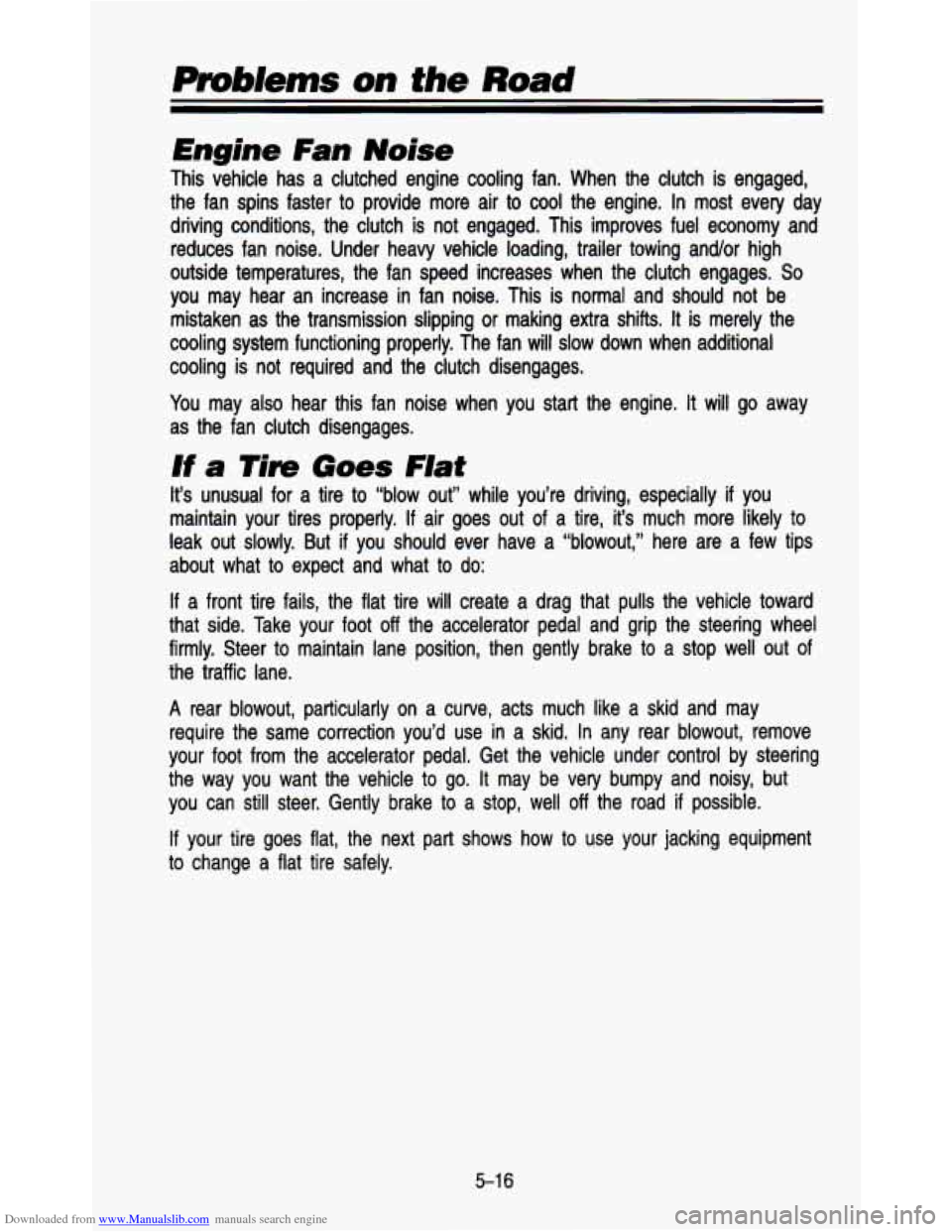
Downloaded from www.Manualslib.com manuals search engine Pmblems on the Road
Engine Fan Noise
This vehicle has a clutched engine cooling fan. When the clutc\
h is engaged,
the fan spins faster
to provide more air to cool the engine. In most every day
driving conditions, the clutch is not engaged. This improves fu\
el economy and
reduces fan noise. Under heavy vehicle loading, trailer towing \
andlor high
outside temperatures, the fan speed increases when the clutch e\
ngages.
So
you may hear an increase in fan noise. This is normal and should not be
mistaken as the transmission slipping
or making extra shifts. It is merely the
cooling system functioning properly. The fan will slow down whe\
n additional
cooling is not required and the clutch disengages.
You may also hear this fan noise when you start the engine.
It will go away
as the fan clutch disengages.
If a Tim Goes Flat
It’s unusual for a tire to “blow out” while you’re driving, especially if you
maintain your tires properly.
If air goes out of a tire, it’s much more likely to
leak out slowly. But
if you should ever have a “blowout,” here are a few tips
about what to expect and what
to do:
If a front tire fails, the flat tire will create a drag that pulls the vehicle toward
that side. Take your foot
off the accelerator pedal and grip the steering wheel
firmly. Steer
to maintain lane position, then gently brake to a stop well out of
the traffic lane.
A rear blowout, particularly on a curve, acts much like a skid \
and may
require the same correction you’d use in a skid. In any rear blowout, remove
your foot from the accelerator pedal. Get the vehicle under co\
ntrol by steering
the way you want the vehicle
to go. It may be very bumpy and noisy, but
you can still steer. Gently brake
to a stop, well off the road if possible.
If your tire goes flat, the next part shows how to use your jacking equipment
to change a flat tire safely.
5-1 6
Page 221 of 345
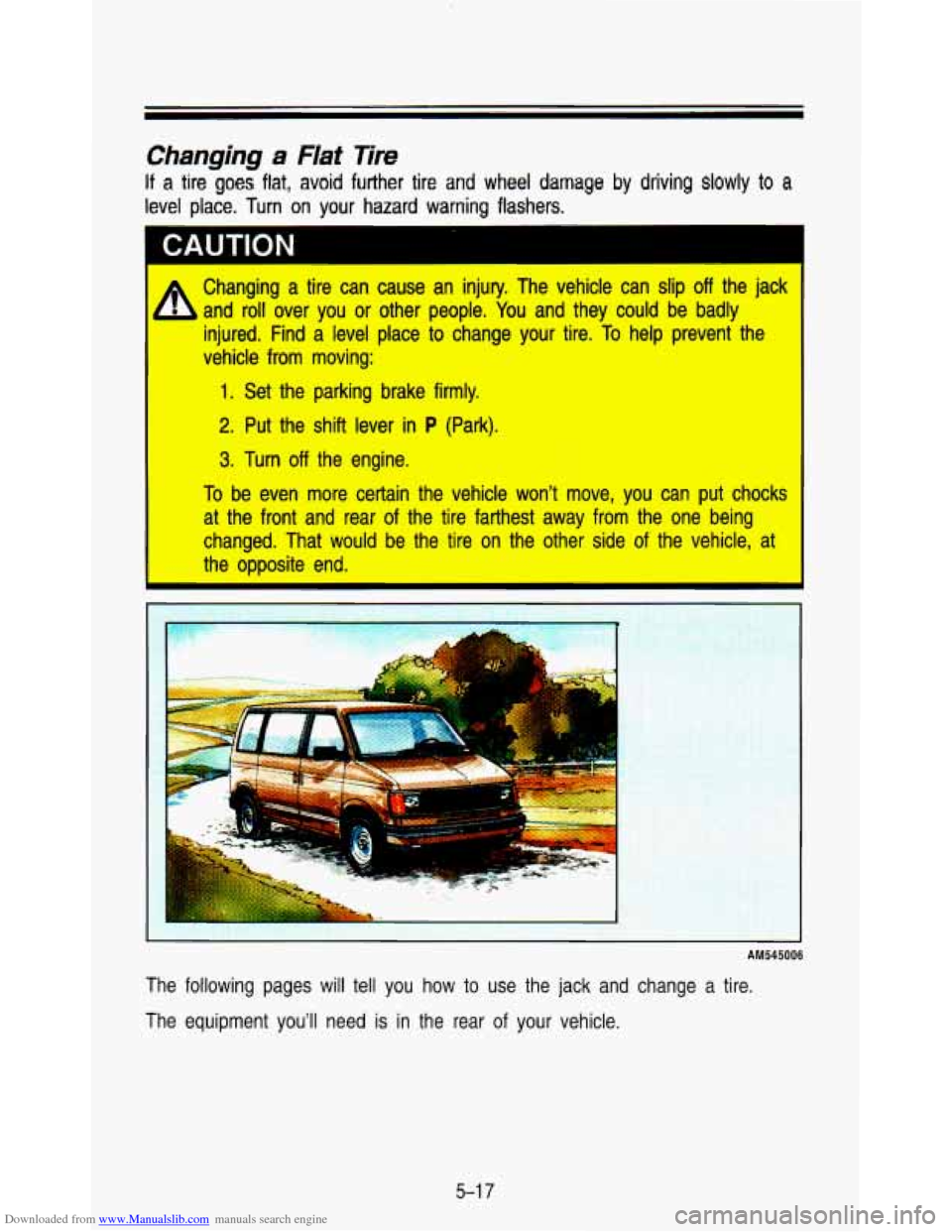
Downloaded from www.Manualslib.com manuals search engine Changing a Flat Tire
If a tire goes flat, avoid further tire and wheel damage by driving slowly to a
level place. Turn on your hazard warning flashers.
I CAUTION
4
Changing a tire can cause an injury. The vehicle can slip off the jack
and
roll over you or other people. You and they could be badly
injured. Find a level place
to change your tire. To help prevent the
vehicle from moving:
1. Set the parking brake firmly.
2. Put the shift lever in P (Park).
3. Turn off the engine.
To be even more certain the vehicle won’t move, you can put chocks
at the front and rear of the tire farthest away
from the one being
changed. That would be the tire on the other side
of the vehicle, at
the opposite end.
I
I
AM545006
The following pages will tell you how to use the jack and change a tire.
The equipment you’ll need
is in the rear of your vehicle.
5-1 7
Page 222 of 345

Downloaded from www.Manualslib.com manuals search engine Pmblerns on the Road
Jack Storage
F 0
Your jack, extension, ratchet and wheel blocks are stored by your v\
ehicle’s
rear doors, along the passenger side wall.
To remove your jack cover, take off the plastic wing nut by turning it
counterclockwise. Lift up on the latch and pull the jack cover off.
5-1 8